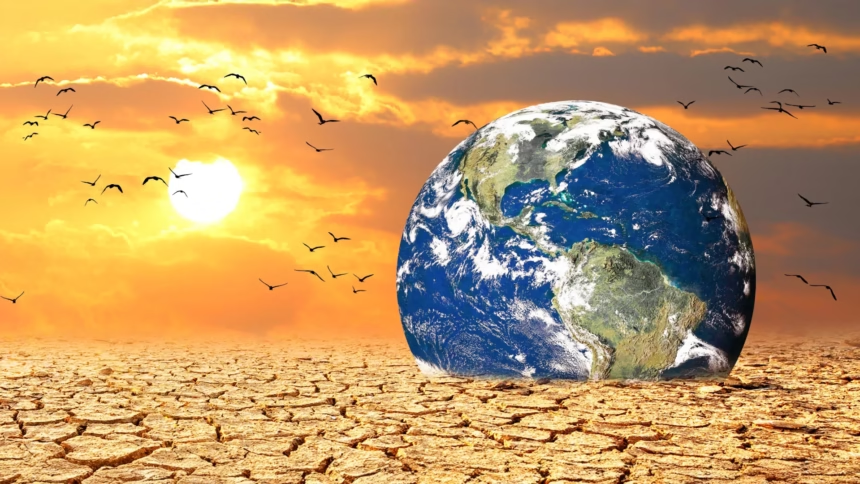What if next summer felt hotter than the last, not as a fluke, but as the new normal? That is where we are. The climate change effects 2025 are no longer distant. They are here, they are measurable, and they touch daily life, from food prices to flood risk.
Last year was the hottest year on record, made worse by El Niño riding on top of long-term warming. Early data shows 2025 is tracking as one of the warmest years ever recorded. The planet has warmed about 1.4°C since the late 1800s.
There is less than a 10% chance that 2025 will average above 1.5°C for the full year, yet scientists expect the long-term average to cross that mark in the early 2030s without fast cuts in emissions. Arctic sea ice hit record lows in mid 2025, a clear signal of rapid warming at the poles.
Here is what you will get from this guide: what is changing now, why it matters for people and nature, and what we can do this year to cut risk and cost.
2025 at a glance: heat records, the 1.5°C limit, and why it matters
The last decade tells a simple story. Every year from 2015 to 2024 ranks among the hottest on record. That is a clear trend driven by heat-trapping gases. El Niño helped push 2024 over the top, yet the background warming comes from carbon dioxide, methane, and nitrous oxide in the air.
The 1.5°C threshold is a long-term average used to guide risk, not a single day or month. It sets a level where the chances of severe impacts rise. In 2025, the world is likely to post the second or third warmest year so far, even if it does not beat 2024. The signal is consistent and strong, and the implications are personal.
Will 2025 be one of the hottest years on record?
Yes. Multiple agencies report that 2025 is on track to be among the hottest years ever recorded, likely second or third. That is not a one-off. It fits a decade-long trend of record heat and more frequent extremes.
The 1.5°C threshold explained in simple terms
Think of 1.5°C like a speed limit for risk. It is an average over years, not a daily reading. The chance that 2025 averages above 1.5°C is below 10%, yet without rapid cuts now, scientists expect the world to pass this mark in the early 2030s. Why it matters: higher odds of dangerous heatwaves, more stress on crops, and more coastal flooding as seas rise.
Greenhouse gases at record highs are the driver
Carbon dioxide, methane, and nitrous oxide are at record levels. These gases trap more heat, which raises the odds of heatwaves, heavy downpours, wildfire weather, and drought. That is the core driver behind the climate change effects 2025.
Extreme weather in 2025: fires, floods, drought, and heatwaves
You can see climate signals in daily life. Wildfire seasons are longer in many fire-prone regions. Some places face heavier downpours and flash floods, while others slip into deeper drought. In some areas the growing season is longer, which can help early harvests, but heat and water stress can still cut yields. Health impacts grow too, with the WHO warning that rising temperatures and air pollution are major health threats.
For a recent real-world example in Southeast Asia, see how torrential monsoon rains drove severe flooding in northern Thailand: 2025 Chiang Mai floods linked to climate change.
Wildfire seasons are longer and more intense
Warming and drought dry out vegetation. Drier fuel burns faster and hotter. Research links human-caused climate change to a doubling of burned area in parts of the U.S. West over recent decades, with risks projected to increase by mid-century if emissions remain high. In 2025, that means planning ahead: early warnings, fuel management, and safer building and landscaping near wildlands.
Floods in some places, deeper drought in others
A warmer atmosphere holds more moisture. When storms form, they can unload intense rain, which pushes up urban flood risk. At the same time, shifting patterns can leave other regions drier for longer, eroding soils and cutting river flow. The result is stress on food, water, and infrastructure. Cities must manage sudden cloudbursts. Rural areas must prepare for failed rains and low reservoirs.
Heatwaves and health: keeping people safe
Heatwaves are more frequent, longer, and hotter. The most at risk are older adults, children, outdoor workers, pregnant people, and those with heart or lung disease. Simple steps save lives: find shade, drink water, use cool spaces, and follow early alerts. Employers can add rest cycles and shade. Local authorities can open cooling centres and run check-in programmes for people living alone.
Oceans and ice in 2025: rising seas and a shrinking Arctic
The ocean and ice system tells the story in slow motion. Arctic sea ice dropped to record lows in mid 2025. If current trends hold, the Arctic Ocean could see nearly ice-free late summers before the middle of the century. Sea level rise continues as warm water expands and melting glaciers and ice sheets add water. Warmer seas can also feed stronger storms.
Arctic sea ice hit record lows in mid 2025
Less sea ice means less sunlight reflected back to space. Darker ocean water absorbs more heat, which speeds warming. This feedback is one reason polar regions are heating faster than the global average. That shift affects weather patterns far from the Arctic.
Sea level rise is locked in, so coastal risk grows
Seas will keep rising for decades because the system responds slowly to past emissions. Coastal communities face more frequent tidal flooding, saltwater pushing into freshwater supplies, and higher storm surge risks through the 2030s and beyond. Raising roads and seawalls, restoring dunes and mangroves, and smarter zoning can lower damage and insurance costs.
Warmer oceans can mean stronger storms
Warm surface waters add fuel to storms. This can mean heavier rainfall, larger flood peaks, and a higher chance that storms rapidly intensify. Forecasting is improving, yet the safest gains in 2025 will come from better drainage, power backup plans, and stronger buildings in high-risk areas.
Nature, food, and water: who and what is at risk in 2025?
As warming pushes toward 1.5°C to 2°C, many species lose suitable habitat. Some shift upslope or poleward, yet many cannot move fast enough or hit walls made by roads, farms, or cities. On our current path, up to 3 billion people could face periods of heat that feel unbearable by 2070. Plastic pollution, overuse of water, and habitat loss pile on, which worsens climate stress.
Growing seasons are shifting. That helps some places harvest earlier, yet heat spikes, dry spells, and floods can still slash yields and spoil storage. Water supply is under pressure where snowpacks shrink or monsoons swing between extremes.
Wildlife on the move, but many species cannot keep up
Animals and plants track the climate they need. Birds arrive earlier in spring, insects emerge sooner, and plants flower earlier. Timing mismatches follow. A pollinator may miss peak bloom, or a chick may hatch after the best feeding window. Barriers like highways and fragmented forests slow movement. Alpine and island species are especially sensitive because they have few places to go.
Crops and water security under pressure
Heatwaves, drought, and floods hit yields. Wheat and maize are sensitive to high heat during flowering. Rice paddies suffer when floods linger. A longer frost-free season can help in cooler regions, yet gains fade when heat stress rises or water runs short. Irrigation has limits when rivers shrink or aquifers are overdrawn. Better storage, drip systems, and soil moisture management help, yet they need funding and training.
Compounding threats make impacts worse
Climate stress rarely acts alone. Pollution, invasive species, and habitat loss add pressure. Coral reefs face warming, ocean heatwaves, and local water quality problems. Forests face drought and pests, then fires. In 2025, smart policy needs to cut multiple risks together, for example, reducing runoff, protecting habitat corridors, and managing fire fuel in one plan.
What we can do in 2025 to cut risk and costs
This is the year to act on both fronts: cut emissions and adapt to the changes already here. Current national plans still point to rising fossil fuel output, which makes the 1.5°C goal harder to meet. That is the production gap. Closing it means shifting investment and policies now. At the same time, targeted adaptation can save lives and money this year.
Slash emissions: power, transport, buildings
- Accelerate wind and solar projects, and modernise grids that connect them.
- Retire the dirtiest power plants, and set clear timetables for phase-out.
- Electrify buses and city fleets, and expand EV charging along key routes.
- Insulate homes and offices to cut bills, and switch to heat pumps where practical.
- Upgrade industrial efficiency, including motors, boilers, and heat recovery.
Adapt now: heat health plans, fire and flood readiness
- Set up heat-health plans: cooling centres, shade at bus stops, and text alerts.
- Protect homes in fire-prone areas: defensible space, ember-resistant vents, and safer roofs.
- Use controlled burns and fuel breaks where safe to lower extreme fire risk.
- Upgrade drainage in cities to handle cloudbursts, and protect natural buffers like wetlands.
- Improve building codes to match current flood, wind, and heat risks.
Finance and policy that speed up change
Stable funding and fair rules drive faster progress. Public and private finance can support upgrades in housing, transport, and grids. Insurance reforms should reward safer building and risk reduction, not only rebuild after loss. Planning rules need to steer new construction away from high-risk zones. Recovery funds should help communities build back safer and help those most at risk first.
Everyday choices that add up in 2025
Small steps matter when millions join in.
- Save energy at home: LED lighting, smart thermostats, and shorter hot showers.
- Choose public transport, cycling, or car share when possible.
- Cut food waste with better planning and storage, and enjoy more plant-rich meals.
- Support local nature projects that plant trees, restore rivers, or green schoolyards.
- Vote and speak up for climate-smart policies at work and in your community.
Quick guide: causes, signals, and impacts
| What is happening | Why it is happening | What it means in 2025 |
|---|---|---|
| Record global heat | Greenhouse gases trap extra heat | More heatwaves, higher power demand |
| Record-low Arctic sea ice | Rapid polar warming and feedbacks | Faster warming, shifting weather patterns |
| Heavier downpours | Warmer air holds and releases more moisture | More urban floods and landslides |
| Deeper drought in dry regions | Shifting rainfall and hotter conditions | Water stress, crop losses, higher prices |
| Rising seas | Ocean warming and melting land ice | Tidal flooding, stronger storm surge |
| Longer fire seasons | Hotter, drier fuels and more ignitions | Larger fires and smoke health risks |
Conclusion
The climate change effects 2025 are already shaping our weather, health, coasts, and nature. This year may be the second or third warmest on record, Arctic sea ice is at record lows, and extremes are more common.
Faster cuts in emissions, paired with smart adaptation, can protect lives, nature, and budgets. Take steps at home, at work, and in your community, and push for policies that match today’s risks. The window is tight, yet the tools are in our hands.














